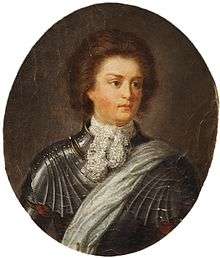Philip Christoph von Königsmarck

Philip Christoph von Königsmarck or Philipp Christoph Königsmarck, (Stade, 4 March 1665[1] – 2 July 1694,[2][3] Hanover) was a Swedish count[4] of Brandenburgian extraction and a soldier.[2] He was allegedly the lover of Sophia Dorothea, Princess of Celle, the wife of Duke George Louis of Brunswick and Lunenburg, the heir presumptive of the Principality of Calenberg, later to become Elector of Hanover (as George I Louis, 1708) and King of Great Britain (as George I, 1714).[5]
Background
Königsmarck was the grandson to the Swedish Field Marshal Hans Christoff von Königsmarck, Bremen-Verden's governor general in Stade, and nephew to the Swedish Field Marshal Otto Wilhelm Königsmarck and Beata Elisabet von Königsmarck. He was the son of Count Kurt Christoph von Königsmarck (1634-1673), son of Hans Christoff von Königsmarck, and Countess Maria Christina von Wrangel (1628-1691), daughter of Count Hermann von Wrangel. His sister Maria Aurora of Königsmarck was later mistress to Augustus II the Strong of Poland, with whom she had the son Maurice de Saxe, the brilliant French military commander. His other sister Amalia Wilhelmina was a noted dilettante artist. His brother Karl Johann von Königsmarck is alleged to have hired three assassins to kill Thomas Thynne – husband of heiress Elizabeth Seymour, Duchess of Somerset,[6] whom Königsmarck had been wooing – on 12 February 1681. The assassins were hanged on 10 March 1682 though their alleged hirer was acquitted.
Disappearance
After wandering and fighting in various parts of Europe he entered the service of Ernest Augustus, Elector of Hanover. Here he made the acquaintance of Sophia Dorothea, and assisted her in one or two futile attempts to escape from her husband in Hanover. Remembered as the lover of the princess, due to the large amount of love letters that are now preserved at the University of Lund.[7] On the morning of 2 July 1694, after a meeting with Sophia at the Leineschloss castle, Königsmark was seized and disappeared.[8]
He was murdered at the instigation of George Louis, and his body was presumed to be disposed of in in the Leine river upon which the Leineschloss is situated.[5][6] It is alleged that two of those involved in his death made confessions years later.[9] In August 2016 a human skeleton was found under the Leineschloss castle during a renovation project; it is believed that these bones are the remains of Königsmarck.[10][11]
Publication
Most of the letters alleged to have passed between Königsmarck and Sophia Dorothea were published by William Henry Wilkins in The love of an uncrowned queen (2 parts, 1900). It is not absolutely certain that Sophia Dorothea was guilty of a criminal intrigue with Königsmarck, as it is probable that the letters which purport to have passed between the pair are forgeries. The question of her guilt or innocence, however, has been and still remains a fruitful and popular subject for romance and speculation.[8]
The 1948 costume historical romantic film, Saraband for Dead Lovers (called Saraband in the U.S.) starring Stewart Granger, Joan Greenwood, Peter Bull, Flora Robson, and Anthony Quayle and directed by Basil Dearden is based on the story.
References
- ↑ "Today in History » March 4 in history". Retrieved 2007-06-29.
- 1 2 Great Mysteries of the Past. New York: Reader's Digest. 1991. p. 37. ISBN 0-89577-377-5.
- ↑ 4 March and 2 July in the Old Style Julian calendar still in use at this time in the Duchy of Bremen (country of birth) and the Principality of Calenberg (country of death).
- ↑ "Family Ancestry Georgian England George I". Retrieved 2007-06-29.
- 1 2 "George I Feature Page on Undiscovered Scotland". Retrieved 2007-06-29.
- 1 2 Charles John Königsmarck The Newgate Calendar
- ↑ Herman, Eleanor (2006). Sex With The Queen. HarperCollins Publishers. ISBN 978-0-06-084674-9.
- 1 2
 Chisholm, Hugh, ed. (1911). "Königsmark, Philipp Christoph, Count of". Encyclopædia Britannica (11th ed.). Cambridge University Press.
Chisholm, Hugh, ed. (1911). "Königsmark, Philipp Christoph, Count of". Encyclopædia Britannica (11th ed.). Cambridge University Press. - ↑ Memoirs of Sophia Dorothea, Consort of George I Robert Folkestone Williams
- ↑ A Skeleton Found in a Castle Could Be the Key to Cracking a 17th-Century Cold Case Smithsonian Magazine, 18 October 2016
- ↑ Lag ermordeter Graf 323 Jahre unterm Leineschloss Hannoversche Allgemeine, 26 August 2016 (German)